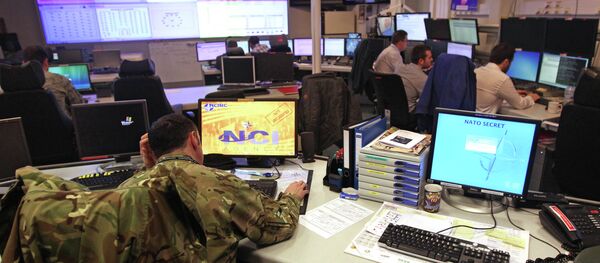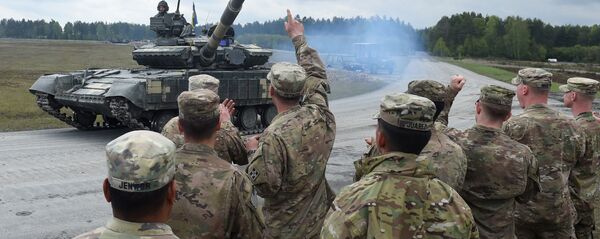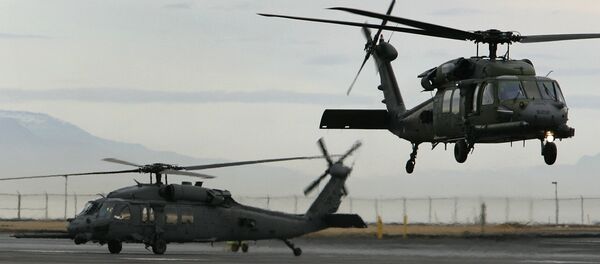It was a regular sight in Western Germany some 30 years ago, on main roads and motorways: long columns of tanks and armored vehicles, during NATO manoeuvres. Not any more, for many years, since the cold war ended and most foreign troops left.
Europe Rearming
But now the issue of militarization is back with a vengeance. Since Crimea rejoined Russia in 2014, NATO has woken up to the supposed "danger" that Russia represents. The Alliance officials and the military are fanning the flames to ensure military budgets finally start increasing again.
US President Donald Trump helped them in this endeavor by urging NATO members to pay their fair share and to respect the 2-percent threshold for military expenses.
The talk of war means billion of euros in investment for the defense industry and its lobbyists.
One of the most acute issues with the defense of Europe is the fact that the continent has significantly improved its civilian transport infrastructure in the last 18 years: motorways, high speed train networks, new airports. The problem is that the military logistics has not caught up.
Military Mobility Plan
The debate over Europe's ability to deploy troops across its territory was launched by the United States and NATO in 2014. EU transport commissioner Violeta Bulc said at a press conference on Wednesday that the quick deployment of troops was a necessity.
Under the Military Mobility Plan unveiled Wednesday, the Commission, the member states and the European Defense Agency will outline the military requirements, including the definition of infrastructure needed, and identify how they fit with current regulations.
The military will have to define the railroads network that would be "core priority" in case of major alert. Track gauges may present a problem there. Parts of Poland, Slovakia and the three Baltic states still have a larger gauge that the erst of Europe.
A network of military-compatible airports has to be outlined, as well as the waterway connections.
The ultimate goal is to draw up by the end of 2019 a list of "dual-use" projects to improve infrastructure that could be used both for civilian and military transport.
Core Corridors by 2030
The plan is to set up and adapt nine East-West and North-South "core network corridors" by 2030. The price tag, just for the core corridors, is 500 billion euros ($615 billion), a significant amount, even for the whole bloc.
Bulc said at the press conference that the Commission was not "aware of the amount of money" required. Member states would decide how far to go on the expenses.
Federica Mogherini, the High Commissioner for Foreign Affairs of Europe, urged for a close cooperation with NATO on military mobility.
Bulc said, however, that NATO and the EU did not work together on the plan. She stressed that the mobility plan was "part of the EU defense strategy, not NATO’s."
Miitary Questions Plan
NATO countries have already signed an agreement on the compatibility of of equipment and procedures, a retired colonel, who at one point was head of the department in charge of STANAGs (standardization agreements) and was involved in many logistics discussions during his career, in Europe, former Yougolavia and Afghanistan, told Sputnik.
"A 'good' country would arrive at a score of 7 percent of ratified STANAGs actually implemented in the units. It was the same at NAMSA (NATO maintenance and supply agency in Luxembourg) and for the acceptance of ISO standards by each country. Very patchy application of standardization!" the retired colonel said.
"At the operational level, there are not too many problems for the constitution of allied headquarters (EUROCORPS, for example) and their operation, since we use the same procedures. But giving battalions to these staffs is another matter: one does not easily find candidates and ROE (rules of engagement) vary from country to country. A huge harmonization effort is needed," the retired colonel said.
The United Kingdom and the United States "set the tone" at the Supreme Headquarters Allied Powers Europe (SHAPE), another anonymous source, an engineer officer at the SHAPE until recently, told Sputnik.
"Each army has excellent equipment using the newest technologies, but they are all different. As long as there is no common foreign policy in the EU (which is still the core of NATO) and a European Defence budget, European member states will continue to watch their navel," the source told Sputnik.
"On the other hand, the Russians have only one range of armored infantry vehicles, tanks, planes, produced at home. They use the same electronics and software… Interoperability in NATO is not for tomorrow. So, I consider the issue of the 'core corridors' for transport as interesting but it is just one more hurdle to be efficient in case of real war. There should be other logistics priorities," the military expert said.
Politicians Disagree With Russian Threat Idea
The financial discussion at EU level and debates in the European Parliament will be tough. The size of spending itself as well as relations with Russia may turn out to be stumbling blocks for parties on both sides of the political spectrum.
"We can’t accept Europe to be openly anti-Russian. My party, the FN [Front National] wants France to regain full sovereignty over National Defense policy. That is why we are not in favour of the prospect of a European "defence union" at the boot of the United States and NATO," Gilles Lebreton, member of the European Parliament from France told Sputnik.
The FN would like to promote the idea of the balance between the great powers, Lebreton said.
"For the rest, France will obviously have to maintain bilateral military cooperation with Great Britain," the politician added.
The politicians in Germany are also not unanimous on the issue of alleged Russian threat.
The right-wing Alternative for Germany (AfD) party does not see Russia as a danger, Joerg Meuthen, a European parliament member from AfD told Sputnik.
"We consider Russia as a very important and esteemed neighbor, with whom, in our own interests, we should have good relations, as well as with other important nations. Apparently, however, the entire federal government (in Berlin) seems to have lost their elementary foreign policy compass by now," Meuthen said.
NATO and the EU need to look at the huge logistical problems that appear alongside the need to choreograph the actions of 28 different armies, with different equipment and speaking different languages. Creating nine logistical corridors across the continent is a difficult task.
That could take some time, leaving Europe apparently vulnerable to any imminent threat.










